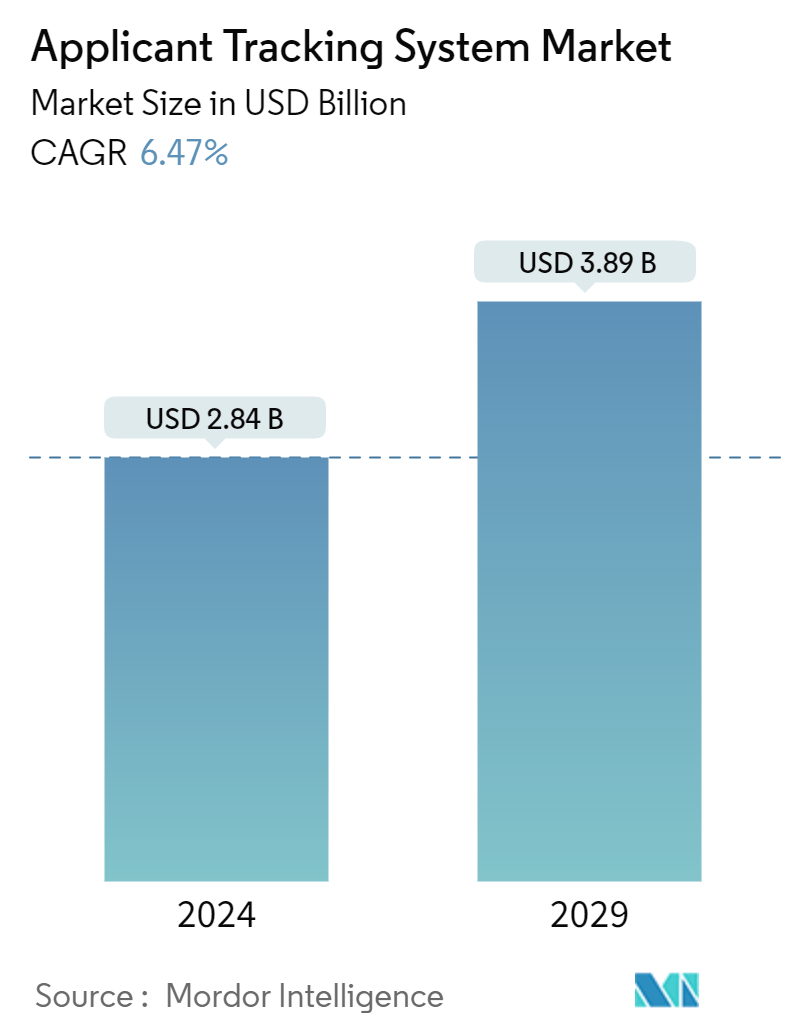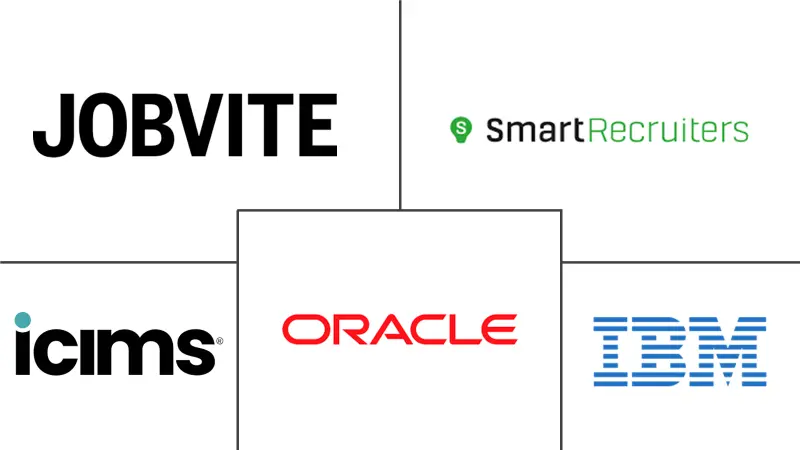Market Size of Applicant Tracking System Industry

| Study Period | 2019 - 2029 |
| Market Size (2024) | USD 2.84 Billion |
| Market Size (2029) | USD 3.89 Billion |
| CAGR (2024 - 2029) | 6.47 % |
| Fastest Growing Market | North America |
| Largest Market | North America |
Major Players*Disclaimer: Major Players sorted in no particular order |
Applicant Tracking System (ATS) Market Analysis
The Applicant Tracking System Market size is estimated at USD 2.84 billion in 2024, and is expected to reach USD 3.89 billion by 2029, growing at a CAGR of 6.47% during the forecast period (2024-2029).
The applicant tracking system (ATS) market has rapidly evolved into a cornerstone of modern recruitment processes. ATS software enables companies to manage large volumes of candidates, monitor applications, and streamline hiring workflows. Over the past few years, the increasing complexity of talent acquisition and the demand for advanced recruitment management tools have spurred innovation and growth in this sector. Organizations are turning to automated hiring solutions, not only to improve efficiency but also to enhance the overall recruitment experience.
AI-driven technologies are reshaping the ATS landscape, enhancing the recruitment process by automating candidate screening, predicting hiring outcomes, and optimizing job postings. Vendors are responding by offering increasingly sophisticated and customizable platforms tailored to diverse industries such as IT, healthcare, and retail. The shift toward cloud-based ATS platforms is particularly notable, as they provide flexibility, scalability, and seamless integration with other HR tools. These solutions have become critical in industries with high-volume hiring demands, although challenges related to the technical complexity of ATS implementations remain.
Growing Need for Automation in Recruitment
- Automation in recruitment: The demand for automating recruitment processes is a primary driver of the ATS market. Organizations, especially those handling large applicant pools, rely on automation to streamline tasks and reduce the time spent on manual processes such as application filtering.
- Efficiency through automation: Automated hiring tools, including AI-powered systems, allow recruiters to focus on higher-value tasks, reducing the time-to-hire and improving candidate experience. These systems can handle repetitive tasks like candidate sourcing and scheduling, allowing HR teams to work more efficiently.
- AI integration: Artificial intelligence has further enhanced ATS platforms, offering predictive capabilities that help companies identify the best candidates faster, thereby reducing cost-per-hire. Automation also facilitates quicker decision-making by minimizing bottlenecks in the recruitment process.
- Cloud-based demand: The trend toward cloud-based ATS platforms continues to rise, with companies seeking systems that integrate with other HR tools and offer real-time access to recruitment data. These platforms are particularly valuable for businesses needing scalable, remote solutions, especially in the wake of growing remote work trends.
Diversity in Talent Acquisition
- Bias reduction through ATS: As diversity becomes a key focus for organizations, ATS platforms are evolving to reduce bias in hiring processes. Algorithms in modern ATS software promote fair candidate assessments, ensuring diverse talent pools are considered equitably.
- Inclusion-driven tools: Recruitment software vendors are also developing features aimed at improving inclusivity, helping employers reach underrepresented talent groups. This aligns with companies’ increased emphasis on workforce diversity, ensuring compliance with equal employment standards.
- AI for diversity: AI-driven applicant tracking systems are aiding companies in reducing unconscious biases, promoting more inclusive hiring practices. These tools also facilitate blind recruitment, allowing organizations to tailor recruitment strategies that align with their diversity goals.
- Customizable platforms: As diversity gains more importance, the ATS market is seeing a rise in customizable platforms. Vendors are offering solutions that allow businesses to adapt their recruitment strategies to specific diversity objectives, enhancing inclusivity and compliance with corporate policies.
Applicant Tracking System (ATS) Industry Segmentation
An applicant tracking system is a solution that enables the electronic handling of recruitment requirements. Businesses can access these systems online at different levels depending on their recruitment needs, allowing them to collate and analyze applicant data. An applicant tracking system software is used by companies to recruit employees more efficiently.
The applicant tracking system market is segmented by component type (solutions and services), deployment (on-premise and cloud), end-user verticals (IT and telecommunication, BFSI, retail, healthcare, and other end-user verticals (automotive, industrial manufacturing)), and geography (North America, Europe, Asia-Pacific, Latin America, and Middle East and Africa).
The market sizes and forecasts are provided in terms of value (USD ) for all the above segments.
| Component Type | |
| Solutions | |
| Services |
| Deployment | |
| On-premise | |
| Cloud |
| End-user Verticals | |
| IT and Telecommunication | |
| BFSI | |
| Retail | |
| Healthcare | |
| Other End-user Verticals (Automotive, Industrial Manufacturing) |
| Geography*** | |
| North America | |
| Europe | |
| Asia | |
| Australia and New Zealand | |
| Latin America | |
| Middle East and Africa |
Applicant Tracking System Market Size Summary
The Applicant Tracking System (ATS) market is poised for significant growth, driven by the evolving dynamics of the workforce and the increasing need for efficient recruitment solutions. The shift towards remote and hybrid work models, accelerated by the COVID-19 pandemic, has underscored the importance of ATS in streamlining the hiring process. These systems serve as crucial tools for organizations to manage and optimize their recruitment efforts, helping to collect and organize candidate data, assess skills, and predict success factors. By integrating artificial intelligence and machine learning, ATS can enhance the recruitment process by providing deeper insights into candidate behavior and preferences, thereby improving the quality of hires and reducing time-to-fill. Despite the challenges of integrating new systems with existing recruitment methods, the benefits of data-driven hiring and recruitment marketing analytics are driving the adoption of ATS across various industries.
The North American region, in particular, is witnessing robust growth in the ATS market, fueled by the presence of numerous technology providers and the region's advanced workforce. The demand for ATS solutions is being propelled by the need to modernize HR functions and adopt cloud-based mobility trends. Major players in the market are actively engaging in strategic partnerships and acquisitions to enhance their offerings and meet the rising demand. The competitive landscape is characterized by significant investments in research and development, with companies like iCIMS, Jobvite, and Fountain introducing innovative solutions to streamline the recruiting lifecycle. As employment continues to rise globally, the ATS market is expected to expand, offering substantial opportunities for both established and emerging players in the industry.
Applicant Tracking System Market Size - Table of Contents
-
1. MARKET DYNAMICS
-
1.1 Market Overview
-
1.2 Industry Attractiveness - Porter's Five Forces Analysis
-
1.2.1 Threat of New Entrants
-
1.2.2 Bargaining Power of Buyers/Consumers
-
1.2.3 Bargaining Power of Suppliers
-
1.2.4 Threat of Substitute Products
-
1.2.5 Intensity of Competitive Rivalry
-
-
1.3 Market Drivers
-
1.3.1 Growing Need for Automation in Recruitment
-
1.3.2 Significant Growth in Diverse Talent Acquisition
-
-
1.4 Market Challenges
-
1.4.1 Limited Technical Expertise for Using Advanced ATS and Complexity Involved with the Integration of ATS Software with Other Systems
-
-
1.5 Assessment of the Impact of COVID-19 on the Market
-
-
2. MARKET SEGMENTATION
-
2.1 Component Type
-
2.1.1 Solutions
-
2.1.2 Services
-
-
2.2 Deployment
-
2.2.1 On-premise
-
2.2.2 Cloud
-
-
2.3 End-user Verticals
-
2.3.1 IT and Telecommunication
-
2.3.2 BFSI
-
2.3.3 Retail
-
2.3.4 Healthcare
-
2.3.5 Other End-user Verticals (Automotive, Industrial Manufacturing)
-
-
2.4 Geography***
-
2.4.1 North America
-
2.4.2 Europe
-
2.4.3 Asia
-
2.4.4 Australia and New Zealand
-
2.4.5 Latin America
-
2.4.6 Middle East and Africa
-
-
Applicant Tracking System Market Size FAQs
How big is the Applicant Tracking System Market?
The Applicant Tracking System Market size is expected to reach USD 2.84 billion in 2024 and grow at a CAGR of 6.47% to reach USD 3.89 billion by 2029.
What is the current Applicant Tracking System Market size?
In 2024, the Applicant Tracking System Market size is expected to reach USD 2.84 billion.


